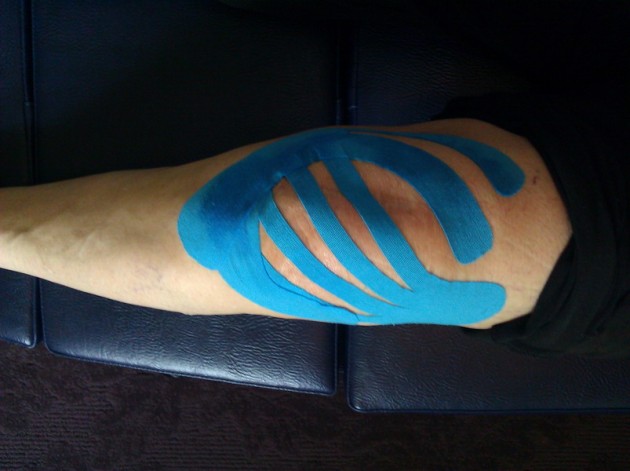
Kinesio Tape
Old-school taping methods would dictate wrapping tape around the entire lower leg — calf, shin, tibia, fibula and all — almost like a mummy. While that would prevent further strain by immobilizing the injured muscle, it would also impede circulation and slow down the body’s natural healing process. Kinesiology taping takes the opposite approach, using the tape to open up the muscle and allow full movement. Kinesiology tape is applied on top of an injured or strained area to stabilize it, but care is always taken to ensure that a muscle or tendon is never encircled with a ring of tape. As you move, the tape, skin and connective tissue (or fascia) over the muscle or tendon also move, pulling slightly away from the muscle and creating space for lymphatic fluid to flow around and cleanse the inflamed tissue.
Dr. Kase lists the following as the four major functions of Kinesio Taping. These functions drive the technology behind the tape:
Supporting the muscle – Proper taping improves the muscle’s ability to contract even when it’s weakened, reduces a feeling of pain and fatigue, and protects the muscle from cramping, over-extension and over-contraction.
Removing congestion to the flow of body fluids – Kinesiology tape improves blood and lymphatic circulation and reduces inflammation and excess chemical buildup in the tissue.
Activating the endogenous analgesic system – “Endogenous” refers to something that is self-originating, and calling something “analgesic” means that it can relieve pain in a conscious person. So, this requirement means that the tape must facilitate the body’s own healing mechanisms, a central focus in chiropractic medicine.
Correcting joint problems – The goal is improving range of motion and adjusting misalignments that result from tightened muscles.
To ensure a full range of motion for the wearer, Kinesio Tape is very thin and made with a porous cotton fabric. The fabric lets the skin breathe and has an elasticity comparable to that of the skin and muscles. The sticky side of the tape uses a water-repellant, medical-grade acrylic adhesive that further supports the muscles and connective tissues. In addition, the tape can stay put for three to four days even through sweating and showering, and Kinesio makes a waterproof tape for use on hands and feet.
Read more news from our Physiotheraphy section.
Check out our Interviews section, every Tuesday a new story, tomorrow read about Mia Jerkov, one of Europe’s best volleyball players, and Turkish Championship’s top scorer.